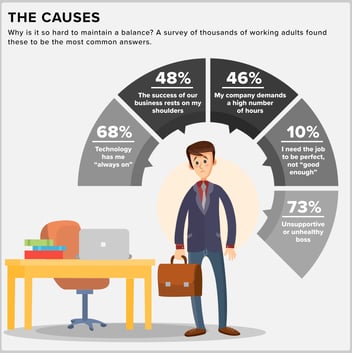The average American worker in non-agricultural fields puts in a little more than half as much time on the job as the average worker in 1830. That should be great news, right? And yet the majority of working people report the struggle to find balance between work and personal life is getting tougher, not easier.
But is this sense of struggle all in our heads? Or are there real reasons we can point to that make balance tougher now than it has been in recent decades?
The short answer is that it’s not just in your head. There are multiple reasons why work-life balance is harder now than it used to be. These include changes to the expectations and demands of home life, parental responsibilities, and (of course) technology. Before turning to solutions, let's look a little closer at these dynamics that are undermining our pursuit of balance.
Work-life Struggle Reason 1: Our Commutes Are Longer
Statistics show that the average American spends more time commuting to work than ever before. And this isn’t due to options like carpooling or public transit. The studies show that we are taking longer to get to work even as we’re increasingly making our commutes alone. In 2016 (the most recent year for this data) the average commute was 26 minutes -- or 52 minutes by the time we get back home! Put another way, if you have 16 waking hours per day, you will spend 6% of your day unable to meaningfully engage with any of your priorities at work or home.
The problem isn’t just the time spent in the car (which is how the majority of Americans get to work); it’s the fact that we’re in cars in the first place, and by ourselves. More time in the car (as opposed to public transportation, riding a bike, or walking) adds to our already sedentary lifestyle and can contribute to our social isolation. So, not only do we lose almost an hour commuting, but the way in which we commute means that we need to block off more time for socializing and exercising in order to compensate for the commuting.
Work-Life Struggle Reason 2: Parenting Requires More Hands-On Time
Expectations on what parenting involves have increased dramatically, especially for middle class and college-educated adults. In addition, people tend to live farther way from extended family (grandparents, aunts, uncles and cousins) who, traditionally, would help with childcare. One study found that moms today spend close to twice as much time taking care of their kids than their 1965 (stay-at-home) counterparts (102 vs 54 minutes). And today’s dads spend almost four-fold more time with their children than they did in 1965 (16 vs 59 minutes).
So, whether you are a man or woman, in a single or two-parent household, you are spending between two and four times as much time parenting compared to parents 50 years ago. Taken together with our daily commutes, a trend of time-scarcity begins to emerge as the average adult has 90 minutes less discretionary time per day.
But wait, we’re not done yet.
Work-Life Struggle Reason 3: Technology Is Taking Bandwidth at Work and Home
The official average American work week is just under 35 hours (more than any Western European country but far less than countries in South America, Eastern Europe and Asia). However, self-reported statistics indicate the the average full-time employee works closer to 47 hours per week. The difference may be in the fact that, for many of us, technology means that we’re always on the job. Much has been written about how email and cell phones keep us in constant contact with our work responsibilities. Which means that you can set all the OOO (out of office) default messages you like; many jobs today require work well-beyond the normal work hours. A forty hour work week for salaried employees is far more likely to include evening and weekend work from home and even on family vacations.
With the boundaries of work more fluid than ever, blocking time for family and self (with their increased demands) becomes even more difficult.
Moving Towards Better Work-Life Balance
If you want to make work-life balance easier, you will need to address these three key areas in your life, finding ways to spend quality time with your kids while minimizing your commute and blocking out times for when you are or are not connected to technology.
I will be the first to say that this is not a quick fix. Our current struggles in work-life balance are decades in the making. But if you'd like some ideas on how to start improving in this area, we've put together a resource we call "The Busy Person's Guide to Work-Life Balance." You're also welcome to leave a comment for me below. Have you noticed differences between how your parents managed time and what your balance looks like? What stands out?
Photo credit: Annie Spratt on Unsplash





